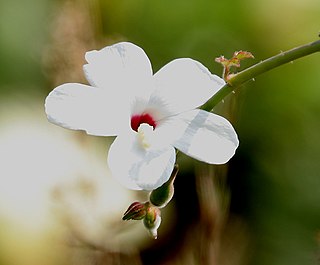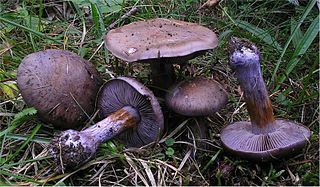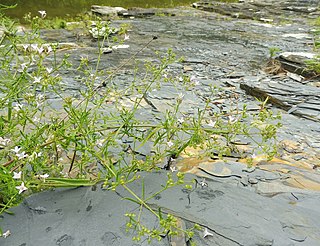
Lagerstroemia, commonly known as crape myrtle, is a genus of around 50 species of deciduous and evergreen trees and shrubs native to the Indian subcontinent, southeast Asia, northern Australia, and other parts of Oceania, cultivated in warmer climates around the world. It is a member of the family Lythraceae, which is also known as the loosestrife family. The genus is named after Swedish merchant Magnus von Lagerström, a director of the Swedish East India Company, who supplied Carl Linnaeus with plants he collected. These flowering trees are beautifully colored and are often planted both privately and commercially as ornamentals.

Salvia officinalis, the common sage or sage, is a perennial, evergreen subshrub, with woody stems, grayish leaves, and blue to purplish flowers. It is a member of the mint family Lamiaceae and native to the Mediterranean region, though it has been naturalized in many places throughout the world. It has a long history of medicinal and culinary use, and in modern times it has been used as an ornamental garden plant. The common name "sage" is also used for closely related species and cultivars.

Magnolia liliiflora is a small tree native to southwest China, but cultivated for centuries elsewhere in China and also Japan. Variously known by many names, including Mulan magnolia, purple magnolia, red magnolia, lily magnolia, tulip magnolia and woody-orchid, it was first introduced to English-speaking countries from cultivated Japanese origins, and is thus also sometimes called Japanese magnolia, though it is not native to Japan. It is now also planted as an ornamental in North America and Europe, though rather less often than its popular hybrid.

Purple sage has various uses, mostly referring to plants or to Zane Grey's novel Riders of the Purple Sage, set in Utah. There is disagreement about what plant Grey had in mind.

Vitis mustangensis, commonly known as the mustang grape, is a species of grape that is native to the southern United States. Its range includes parts of Mississippi, Alabama, Louisiana, Texas, and Oklahoma.

The elm cultivar Ulmus 'Purpurea', the purple-leaved elm, was listed and described as Ulmus Stricta Purpurea, the 'Upright Purpled-leaved Elm', by John Frederick Wood, F.H.S., in The Midland Florist and Suburban Horticulturist (1851), as Ulmus purpureaHort. by Wesmael (1863), and as Ulmus campestris var. purpurea, syn. Ulmus purpureaHort. by Petzold and Kirchner in Arboretum Muscaviense (1864). Koch's description followed (1872), the various descriptions appearing to tally. Henry (1913) noted that the Ulmus campestris var. purpureaPetz. & Kirchn. grown at Kew as U. montana var. purpurea was "probably of hybrid origin", Ulmus montana being used at the time both for wych elm cultivars and for some of the U. × hollandica group. His description of Kew's U. montana var. purpurea matches that of the commonly-planted 'Purpurea' of the 20th century. His discussion of it (1913) under U. campestris, however, his name for English Elm, may be the reason why 'Purpurea' is sometimes erroneously called U. procera 'Purpurea' (as in USA and Sweden.

Castilleja exserta is a species of plant in the genus Castilleja which includes the Indian paintbrushes. Its common names include purple owl's clover, escobita, and exserted Indian paintbrush.

Salvia is the largest genus of plants in the sage family Lamiaceae, with nearly 1000 species of shrubs, herbaceous perennials, and annuals. Within the Lamiaceae, Salvia is part of the tribe Mentheae within the subfamily Nepetoideae. One of several genera commonly referred to as sage, it includes two widely used herbs, Salvia officinalis and Salvia rosmarinus.

Tasmannia purpurascens, commonly known as the broad-leaved pepperbush or purple pepperbush is a shrub in the primitive family Winteraceae and is only found growing in the Barrington Tops and Ben Halls Gap regions of New South Wales. It is locally abundant in a restricted subalpine habitat with a high rainfall, often growing in the ecotone in association with Antarctic Beech.

Abelmoschus ficulneus is a species of flowering plant in the genus Abelmoschus, family Malvaceae. Commonly known as white wild musk mallow or native rosella, it is fibrous perennial with a woody stem. Its flowers are about an inch in diameter, either pink or white, with a rose center; its leaves are palmate.

Thaxterogaster purpurascens is a species of mushroom producing fungus in the family Cortinariaceae. It is commonly known as the bruising webcap.
Hedyotis (starviolet) is a genus of flowering plants in the family Rubiaceae. Many species of this genus such as Hedyotis biflora, H. corymbosa and H. diffusa are well known medicinal plants. Hedyotis is native to tropical and subtropical Asia and to islands of the northwest Pacific. It comprises about 115 species. The type species for the genus is Hedyotis fruticosa.
Dicerandra cornutissima is a rare species of flowering plant in the mint family known by the common name longspurred mint, longspurred balm, and Robin's mint. It is endemic to Florida in the United States. It is found in Marion County, and possibly Sumter County, but it may have been totally extirpated from the latter. There are 15 known occurrences remaining. The plant was federally listed as an endangered species in 1985.

Eremophila purpurascens, commonly known as purple eremophila, is a flowering plant in the figwort family, Scrophulariaceae and is endemic to Western Australia. It is an erect, bushy shrub with warty leaves and spotted, pink to red flowers.

The Elm cultivar Ulmus 'Myrtifolia Purpurea', the Purple Myrtle-leaved Elm, was first mentioned by Louis de Smet of Ghent (1877) as Ulmus myrtifolia purpurea. An U. campestris myrtifolia purpureaHort. was distributed by Louis van Houtte in the 1880s, by the Späth nursery, Berlin, in the 1890s and early 1900s, and by the Hesse Nursery, Weener, Germany, till the 1930s.

Stenaria is a genus of flowering plants in the family Rubiaceae. It is a small genus, consisting of around six species native to the United States, Mexico, and The Bahamas. All species of Stenaria are restricted to Mexico and the southwestern United States, except for the wide-ranging Stenaria nigricans which extends northward and eastward.

Leptospermum purpurascens, commonly known as the purple-stemmed turkey bush, is a shrub or small tree that is endemic to far north Queensland. It has bark that is purple when new, elliptical to broadly lance-shaped leaves, relatively small white flowers arranged in pairs and small fruit that falls from the plants when the seeds are released.

Daviesia purpurascens, commonly known as purple-leaved daviesia, is a species of flowering plant in the family Fabaceae and is endemic to the south-west of Western Australia. It is a glabrous shrub with many branchlets, scattered, erect, cylindrical, sharply pointed phyllodes and yellow and maroon flowers.

Epacris purpurascens is a species of flowering plant in the heath family Ericaceae and is endemic to eastern New South Wales. It is an erect shrub with egg-shaped or heart-shaped, sharply-pointed leaves and white or pink, tube-shaped flowers.

Impatiens henslowiana is a flowering plant of the Balsaminaceae family, native to the Indian states of Kerala and Tamil Nadu, as well Sri Lanka. It is a large shrub that grows either terrestrially or epiphytically.

















